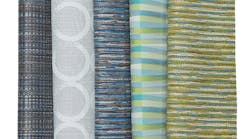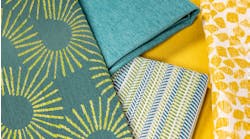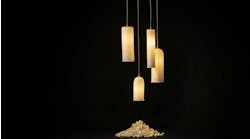Innovation is harder to come by than most companies care to admit. Just stroll down the halls of any design tradeshow and you’ll invariably hear manufacturers tout their product as the next big idea in flooring, lighting, furniture, textiles—whatever. That’s not to say there isn’t a wealth of truly creative, original, and well-designed products regularly introduced to the market. But genuine innovation isn’t very common. That’s why when both Designtex and CF Stinson introduced new lines of responsive textiles featuring Celliant® technology at this year’s NeoCon World’s Trade Fair, we here at interiors+sources were stopped in our tracks.
“Wait—so, this upholstery improves circulation and can actually help people feel better?” we found ourselves asking. “No way,” was our natural response to the answer, “Yes, it can.”
Being the materials geeks we are, we had to learn more about this innovative technology and what it means for textile manufacturing, as well as how it plays into the wellness trend in the design industry today. To that end, we spoke with Hologenix, LLC, the developers of the technology, to answer a series of questions we had about this new breakthrough.
According to information made available from Hologenix, LLC, Celliant is a responsive textile made with patented, cutting-edge fiber technology that incorporates a proprietary blend of 13 thermo-reactive minerals. These minerals reflect naturally emitted infrared energy back to the user’s body to provide performance, health, and wellness benefits. Celliant is a proven vasodilator that improves blood circulation to increase tissue oxygen levels and deliver vital nutrients throughout the user’s body. It is one of the first infrared fiber technologies to be determined as both a medical device and a general wellness product.
How was Celliant developed?
Back in the 1990’s, the inventor’s grandmother experienced complications due to arthritis and diabetes, according to Trenton Horinek, director of sales for Hologenix. “He wanted to find a way to help her with the use of fabrics as opposed to just drugs,” Horinek said. “So, he went on a quest to figure out which minerals in nature from a physics and a chemistry standpoint can actually use the body’s energy to help heal itself.”
Fast forward nearly two decades, and the company discovered and patented a way to grind minerals into a fine powder the size of microns and blended them with a liquid polyester that’s extruded into a fiber for textiles. The company’s proprietary blend of 13 thermal-reactive minerals is a trade secret, but Horinek revealed that three of them include titanium dioxide (found in sunscreens), aluminum oxide, and silicone dioxide. “Those three minerals, all combined with the rest of our formula, create this kind of environment for heat to be absorbed and then converted into infrared energy.”
Once the minerals are embedded into the fiber, Horinek points out that they can never be removed. “They’re there for the whole life of the product, no matter how long you use it.”
Textiles and fabrics made with Celliant technology absorb and convert body heat in the form of infrared energy (IR). This energy is recycled back into skin and tissue in a safe, natural way, helping to rebuild and recharge the human body after physical activity and while you sleep, according to company literature.
For example, Horinek says when a person sits in a chair, their body constantly gives off thermal energy that is ultimately lost. If the chair is covered in Designtex Celliant upholstery or the Stinson Celliant Collection fabric, however, “your body energy would transfer into that chair, into the Celliant fiber, absorb until the minerals are completely full, and then emit out infrared energy onto your skin or tissue, and that [process] happens several times per second,” he explained.
What impact does Celliant have on human health? Is it safe to use?
Referencing the often-repeated mantra, “Sitting is the new smoking,” Horinek says this new technology opens up the opportunity to actually improve circulation for those who sit for extended periods of time, which has been linked to many negative health outcomes. With Celliant, a person sitting in a chair can actually reap the benefits of increased blood flow and circulation while helping to keep the body more tempered.
According to company literature, Celliant is shown to increase tissue oxygenation by as much as eight percent, which helps the body:
- Recover faster from physical activity
- Increase energy, endurance, stamina, and performance
- Promote restful sleep and increased comfort
In terms of its safety, Horinek explains the only danger to users is the potential for an allergic reaction to polyester, one of the fibers used to carry the technology. Beyond that, it is completely safe for use. “The way the product works, it’s not doing anything that your body doesn’t naturally do—it’s just aiding it,” he said. “It’s like riding a Segway instead of walking. It’s helping you move a little bit easier and helping your body function a little bit better,” he explained.
Must-See: The Speakeasy Hiding in a Modern Office
Are the claims verifiable?
Celliant has been extensively researched, developed, and clinically tested for durability and effectiveness. Hologenix has conducted extensive research and completed 10 clinical and physical trials (five of which are published in online peer reviewed journals) with institutions like the University of California Irvine and Texas A&M University. The FDA has determined that Celliant products are medical devices as defined in section 201(h) of the Federal Food, Drug, and Cosmetic Act and are considered general wellness products. The technology was able to achieve this designation because the products that utilize Celliant are intended to affect the structure or function of the body by temporarily promoting increased local blood flow at the site of application in healthy individuals.
Back to the opening commentary on innovation: Horinek says after having worked in the textile industry for 13 years, he’s observed that companies are always looking for the next idea to offer to customers because people are no longer satisfied with just commodities—they want solutions for life. And the ripple effect of this technology will be far-reaching, particularly with the trend toward wellness that’s taking the industry by storm.
“The health hazards of prolonged sitting in the workplace have been well-documented,” said John Rowan, director of sales and product development for CF Stinson, in a press release. “While furniture manufacturers have responded with innovation such as sit-to-stand desks, CF Stinson has looked for ways that textiles and upholstery could also be part of the solution,” he added. “Celliant infrared technology and its benefit to those who sit for extended periods of time in the workplace fulfills a long-held vision of the Stinson team to take performance fabrics to the next level: health-enhancing materials.”
Now Read This: Seven Buildings Repositioned into an Art Dream



